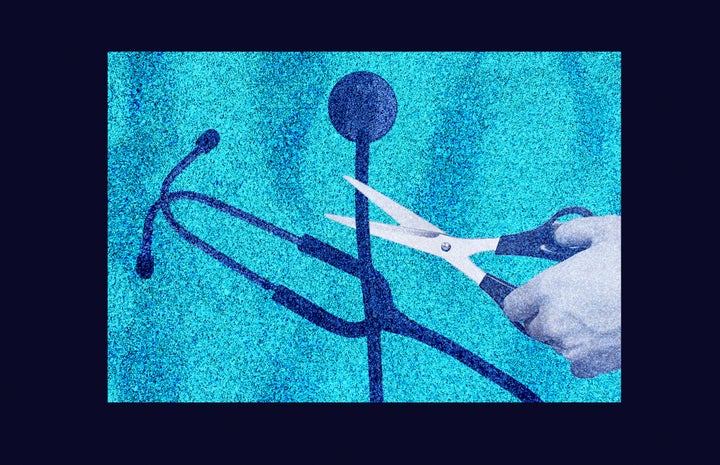🔴 Website 👉 https://u-s-news.com/
Telegram 👉 https://t.me/usnewscom_channel
Earlier this summer, Trump signed the One Big, Beautiful Bill Act into law, which delivers tax cuts to the richest Americans and strips away health care for the poorest.
The bill calls for nearly $1 trillion in cuts to Medicaid, a state and federal health care program that pays for medical procedures and preventative health services for low-income adults and children, folks with disabilities and others with limited resources.
It’s estimated that roughly 12 million people will lose their health care coverage because of this legislation, and the ripple effects are expected to be felt in health systems and hospitals across the country — particularly in rural hospitals.
Decisions in Washington don’t just stay in Washington — they shape lives everywhere. HuffPost is committed to reporting on how policies affect real people. Support journalism that connects the dots. Join our membership program today.
There are 60 million rural Americans, said Alan Morgan, the chief executive officer of the National Rural Health Association. And every single state has at least one rural area, so these Medicaid funding cuts will impact hospitals in every state, whether Kansas, California, Maine, Virginia, New York or wherever. Here’s how:
Illustration: HuffPost; Photos: Getty
Some rural hospitals will be forced to close because of the Medicaid cuts.
“Medicaid really is a foundational pillar of hospital financing in the U.S., particularly for those hospitals that serve low-income, elderly or disabled populations across the country,” said Alan Condon, the editor-in-chief of Becker’s Healthcare, a health care business news publication.
“Hospitals see patients that present themselves at their door, and then they bill for those services, whether it’s private pay, whether it’s Medicaid, whether it’s Medicare, whether it’s the VA … then the hospitals wait to see if they get paid and how much they get paid,” Morgan explained.
“Medicaid accounts, on average, if we take a snapshot of hospitals across the country, it could be anywhere from 15% to 25% of their total revenue,” Condon said, adding that for hospitals known as “safety-net hospitals,” which provide care to uninsured folks and those on Medicaid, Medicaid can account for upward of 45%, 50% or even 60% of total revenue.
Condon said he can’t underscore enough the magnitude the Medicaid cuts will have on hospitals, particularly those that do rely heavily on Medicaid for funding — and this is largely going to impact rural hospitals.
″[Rural America] is a unique health care environment, and I say that because roughly 1 in 4 rural Americans are on Medicaid. Rural America is older, it’s sicker, it’s poorer, and it has a population with high health needs, and in many cases, the inability to pay for health services,” Morgan said.
Providers end up footing the bill a lot of time in these areas, which has led to huge funding problems, Morgan added.
“Before this bill was passed, 45% of rural hospitals were already operating in red, so you’ve got nearly half of all rural hospitals operating at a loss before any cuts, and as a result of that, roughly 300 rural hospitals are at risk for closure now,” Morgan noted. This is only going to get worse as Medicaid funding is ripped from hospitals, he continued.
“There were statements ahead of this bill that the ‘Medicaid cuts may result in rural hospital closures’ — I don’t believe that’s accurate. The Medicaid cuts will result in rural hospital closures,” Morgan said.
“It’s not a maybe when you’ve got [nearly] half already operating at a loss. Any reductions are going to push them over the edge,” he said.

FS Productions via Getty Images
The Medicaid cuts will also mean certain care won’t be available at some rural hospitals.
Some rural hospitals will have enough funding to stay open, but they won’t be able to keep running all aspects of the care they offer, experts say.
“Some rural hospitals stand to lose millions of dollars because they’re not going to be receiving some of the extra funds from the Direct Payment Program, which is eliminated by the One Big, Beautiful Bill Act,” said Laura Dyrda, the vice president of editorial at Becker’s Healthcare.
“For states like Oklahoma, where around 97 hospitals have negative operating margins already and many have a large population of Medicaid beneficiaries, they could have to cut services,” Dyrda added.
There are specific services that tend to get cut first. “What we’ve seen is as finances get more dire, rural hospitals begin to eliminate service lines — usually the first two that are eliminated are maternity care and behavioral health,” Morgan said.
These critical services are generally not profitable for hospitals, Condon added, which is where Medicaid comes in to help fund these programs so communities can get care.
There will also be layoffs at certain rural hospitals.
Beyond actual impacts on health care in rural communities, the Medicaid cuts will lead to layoffs, too, experts say. As hospitals close, people will lose their jobs, whether they work in administration, marketing, finance or are actual doctors and nurses.
These hospitals are often the largest employers in their counties, Morgan said, which will further impact rural communities.
“We’ll unfortunately see a lot more layoffs in some of these hospitals [and] health systems across the country as they try and balance the books to make up the gap,” Condon added.
The risks to rural hospitals are well known; lawmakers added special funding to the One Big, Beautiful Bill Act, but experts say it’s not enough.
The impact these health care funding cuts will have on rural hospitals is known among both Republicans and Democrats, Morgan said.
As talks went on, legislators added an initiative called the Rural Health Transformation Program to the One Big, Beautiful Bill Act, which provides $50 billion in funding over five years to rural health systems, Dyrda said.
“But many leaders that we speak to believe that won’t be enough to cover everything that is being cut from these hospitals,” Dyrda added. At this time, it’s unclear how the funding will actually be administered and split up among hospitals, both Dyrda and Morgan said.
“We are thrilled that there is a recognition of the concern for rural Americans that’s bipartisan, Republicans and Democrats and the administration understand that rural hospitals are at risk, and so we’re glad that they created this fund, but it’s not a comparable trad- off here,” Morgan noted.
Rural hospitals are expected to see funding cuts of $155 billion over 10 years, Morgan said. “And this is $50 billion set aside over five years, so, you’re moving out $155 billion over 10, and you’re putting back $50 billion over five. Those are not the same,” Morgan said.
So, it’s more than “just a Medicaid problem” — it’s a problem for American health care as a whole.
Shouldn’t you care that your low-income neighbors and those with disabilities may get booted from their health care coverage?
“I think the general public just thinks, ‘That’s not my problem, that’s a Medicaid problem.’ They don’t realize that this is about their hometown hospital,” Morgan said.
As mentioned above, these cuts to Medicaid could mean your local rural hospital has to shut down, or maybe the services you need are no longer available there.
“It’s really not safe to live in a community where you’re more than 30 miles from a 24/7 emergency room facility,” Morgan said.
Whether or not you’re on Medicaid and whether or not you live in a rural area, these cuts to Medicaid will still impact you.
“It definitely will significantly and more acutely impact the rural facilities, but that will also, of course, trickle down to some of those urban facilities,” Condon said.
As rural hospitals close or end certain services, “urban hospitals will likely absorb some of those displaced patient populations, which can really strain their emergency departments, ICUs, even their charity care and compensated care budgets as well,” Condon noted.
With that in mind, these cuts to Medicaid aren’t good for anyone, whether you’re on Medicaid, have a loved one on Medicaid or even if you don’t personally know anyone with the health care coverage. These cuts will make America sicker and make necessary health care harder for folks to get.

